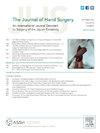桡骨远端骨折固定术后关节碎片脱出和腕关节脱位。
IF 2.1
2区 医学
Q2 ORTHOPEDICS
引用次数: 0
摘要
桡骨远端骨折的手术固定是手外科医生较为常见的手术之一。手术治疗方法取决于多种因素,包括损伤机制、骨折形态、患者特征、骨质、软组织损伤以及外科医生的偏好。对于大多数骨折类型,沃尔锁定钢板固定已成为最常用的骨折固定方法。虽然这种治疗方式并不常见,但也会出现并发症,其中之一就是关节碎片脱出,导致腕关节不稳定。固定失败和腕关节不稳定多见于还原不良或捕获移位的月骨侧切面碎片,也可能发生在其他关注度较低的骨折类型中,尤其是涉及桡骨柱或月骨背侧切面的骨折。术前制定周密计划以识别导致这种并发症的骨折形态至关重要。正确选择用于固定骨折的植入物、术后固定方式的选择和固定时间的长短对于最大限度地减少这种并发症至关重要。我们的目标是:(1)描述与这种并发症相关的解剖结构;(2)对骨折固定后可能发生的各种桡骨远端关节碎片逸出模式进行整理和分类;(3)讨论有助于预防这种并发症的策略。本文章由计算机程序翻译,如有差异,请以英文原文为准。
Articular Fragment Escape and Carpal Subluxation Following Distal Radius Fracture Fixation
Surgical fixation of distal radius fractures is among the more common procedures performed by hand surgeons. The approach to surgical management is based on a variety of factors including injury mechanism, fracture pattern, patient characteristics, bone quality, soft tissue injury, and surgeon preference. For the majority of fracture types, volar locking plate fixation has become the most commonly used method of fracture fixation. Although uncommon, complications can arise following this form of treatment, one of which is escape of an articular fragment with resultant carpal instability. More often seen in conjunction with poorly reduced or captured displaced volar lunate facet fragments, fixation failure and carpal instability can occur with other fracture patterns that have garnered less attention, particularly those involving the radial column or dorsal lunate facet. Thorough preoperative planning to recognize fracture patterns that lead to this complication is paramount. Proper selection of implants used to secure the fracture and the choice as well as duration of postoperative immobilization is critical to minimizing this complication. We aim to (1) describe the relevant anatomy involved with this complication, (2) organize and classify the various distal radius articular fragment escape patterns that can occur following fracture fixation, and (3) discuss strategies that can help prevent this complication.
求助全文
通过发布文献求助,成功后即可免费获取论文全文。
去求助
来源期刊
CiteScore
3.20
自引率
10.50%
发文量
402
审稿时长
12 weeks
期刊介绍:
The Journal of Hand Surgery publishes original, peer-reviewed articles related to the pathophysiology, diagnosis, and treatment of diseases and conditions of the upper extremity; these include both clinical and basic science studies, along with case reports. Special features include Review Articles (including Current Concepts and The Hand Surgery Landscape), Reviews of Books and Media, and Letters to the Editor.

 求助内容:
求助内容: 应助结果提醒方式:
应助结果提醒方式:


